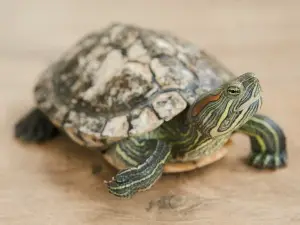
Turtles are animals that are well known for having quite diverse diets. These animals eat a variety of foods including protein sources, fruits, vegetables, and as well as pellets while in captivity.
If your pet turtle stops eating a certain food group, if the animal stops eating veggies, then this behavior may start to worry you. This article looks into why your turtle is not eating vegetables
Table of Contents
Why is my turtle not eating vegetables?
A turtle turning its nose up to leafy greens and other types of produce may start to worry you, this is not normal for turtles and you’ll understandably worry when this happens.
Here is why your turtle may not be eating its vegetables:
It’s the wrong produce:
While it is recommended that you feed your pet turtle greens like kale, lettuce, romaine lettuce, green beans, and other vegetables these animals aren’t actually designed to eat these types of produce.
Some species of turtles, like the red-eared slider, are used to eating vegetation like duckweed, different types of algae, watercress, and other plants that are usually found in their habitat
So, your pet may not be eating vegetables because what you’re feeding it isn’t the produce that it likes.
What to do:
While you likely can’t feed plants from the wild to your pet, what you can do is try to feed your pet foods other than the common grocery store veggies that you may have.
Offer your pet a variety of natural greens and more pellets made for turtles
You can give your pet vegetables like wax beans, sweet potatoes, okra, dandelion greens parsley, red leaf lettuce, grated carrots, green beans, cactus pads, peas in a pod, and occasionally corn on the cob, tomatoes, and mushrooms
It’s not easy to eat:
Turtles like for things to come easy, if it’s easier for them to eat meat and turtle pellets over vegetables then this is what they will do.
The veggies may be harder to eat because they are tough, too large, or simply don’t taste so good.
What to do:
You can make hard vegetables easier to eat by boiling them or steaming them and you can make leafy greens easier to eat by cutting them up and making them smaller to eat.
You can also chop the vegetables into small pieces and then mix them into your pet’s food. You can also grate them into your pet’s food
What can also help is restricting your pet’s live food and leaving fresh vegetables floating in the tank 24/7 this will encourage the animal to eat the vegetables.
The turtle is young:
Another reason why your turtle may not be eating vegetables may be because of its age. Young turtles like young red-eared sliders don’t really eat vegetables and fruits.
These animals in the wild need a lot of protein and calcium to grow so they are predisposed to not eating much produce but rather protein and calcium-rich foods.
What to do:
You’d need to do a deep dive and figure out exactly what type of foods the turtles that you’re raising eat. Research what foods need to be given to turtles at this stage of their life.
Feeding baby turtles successfully can be quite hard and they can easily die so going to the vet and having a professional determine what the animal should eat is also recommended
If you enjoyed this article then you may also be interested in other turtle/tortoise related articles. Here are some articles that you may be interested in: Why Is My Turtle Croaking?, Why Is My Turtle Just Lying There, Why Is My Turtle Going Crazy In Tank, Why Is My Turtle Closing Its Eyes, Why Does My Turtle Just Sit There, Why Is My Turtle Filter Making Noise?, Why Is My Turtle Filter Making Bubbles?, Why Is My Turtle Drooling?, Why Is My Turtle Cold?

